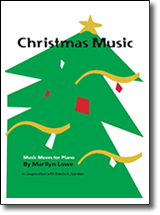Levels One-Four. Boogies and Blues is a collection of light pieces that progress in difficulty and can be used from the first year through the fourth year of study.
Students learn to hear, perform, compose, and improvise with the tonic, subdominant, and dominant chord changes of the traditional blues chord progression.
Duet parts provide models for improvisation.
Levels One-Three. The first part of Music Moves for Two is a collection of two sets of pieces for ensemble playing and improvisation.
In the first set of pieces, the second player imitates the first player.
In the second set of pieces, is a collection of two sets of pieces for ensemble playing and improvisation. One player plays an ostinato pattern while the second player plays the piece, then improvises.
Levels Three -Five (and beyond). The second half of Music Moves for Two is a collection of two sets of more difficult pieces for ensemble playing and improvisation.
In the first set of pieces, the second player improvises an answer to the first player.
In the second set of pieces, one player plays an ostinato pattern while the second player plays the piece, then improvises. Tonalities include Mixolydian, Phrygian, and Lydian. "Mix It Up" is in 5/4.
Levels One - Three. Christmas music is a wonderful way to learn more difficult melodies and more complicated chord changes. Students apply audiation skills, rhythm and tonal patterns, as they learn the songs. This audiation learning process transfers to other music that students hear and want to play.
Here are the steps for learning the tunes: First, sing the melody accurately. Second, learn tonal patterns and rhythm patterns that are characteristic of each melody. Third, play the melody and identify where the characteristic patterns belong in the melody. Fourth, when the melody is secure, transpose it to several keyalities to ensure solid memory of the tune..
Harmonization of the melodies is in the simplest form: a single-tone, root-harmony. Students can hear chord changes best when the bass is the root.of the chord. Identify the chord changes using Roman Numerals and their names (tonic, dominant, and so forth).
When students are secure with the melody and root-harmony, they can play both the melody and bass line in octaves, make arrangements of the accompaniment, change harmonizations, make melodic and rhythmic variations of the melody, and so forth.
Level Four and beyond. The second set of Christmas songs offers more difficult music. While learning new songs, students are encouraged to review all of the songs learned earlier so that they will maintain a permanent repertoire. Students can make arrangements and medleys of the songs they know.
If students add two Christmas carols a year to their repertoire, they will know enough music to be able to entertain, play for group singing, and play for parties during their high school years.
Welcome to this delightful collection of contrasting beginning solos guaranteed to motivate students to imagine, create, and improvise. All pieces may be performed in recitals or for special events.
Students should make creative decisions about each piece. Ideas are included with "Ways to Introduce Pieces to Students," "Steps for Learning a Piece," and "Steps to Make the Piece Your Own.
Students may make mashups, medleys, or arrangements of these pieces, which are learned first by "mindful and meaningful rote." Included also are suggestions for observing notation and understanding music symbols after a student can perform a piece.
NOTE: This book is not eligible for the 10% discount offer.
Upcoming Events
26 January 2026
- Musicianship and Keyboard Activities in Aeolian Tonality 12:00 to 01:00 Online here
23 February 2026
- Musicianship and Keyboard Activities in Lydian Tonality 12:00 to 01:00 Online here
30 March 2026
- Musicianship and Keyboard Activities in Phrygian Tonality 12:00 to 01:00 Online here
27 April 2026
- Musicianship and Keyboard Activities in Locrian Tonality 12:00 to 01:00 Online here
18 May 2026
- Musicianship and Keyboard Activities in Uneven meters 12:00 to 01:00 Online here
15 June 2026
- Musicianship and Keyboard Activities in Everything 12:00 to 01:00 Online here
Online Resources
Podcasts
- Introduction to Audiation-based Piano Instruction and Music Moves for Piano (for new teachers or those interested in learning more)
- Music Moves for Piano Teachers (for current teachers)
Learning Opportunities
Video Podcasts
Tim Topham Interview
About MLT-Piano-based instruction. Click here to view.LIVESTREAM TEACH FOR GROWTH with Nguyễn Ngân
Music Moves for Piano and Edwin E. Gordon's Music Learning Theory. Click here to view.Musical U Team
Mind Before Fingers, with Marilyn White Lowe. Click here to view.MMTA Exclusive
Music Moves for Piano: An Audiation-Based Piano Method Click here to view.Follow Us
Sales Support
Printed books can also be ordered via our distributors:
Digital Sales of Teacher Books/Resources available at: Digital Sales
Please report any incorrect links or non-order related questions to sales@musicmovesforpiano.com



